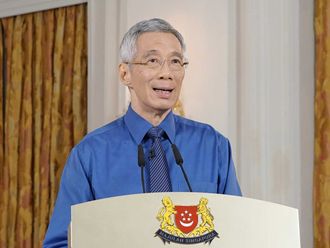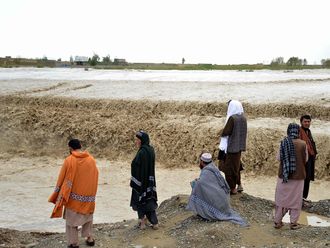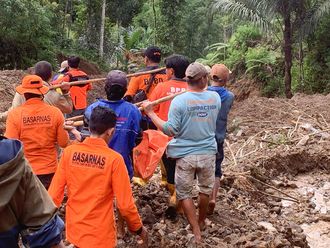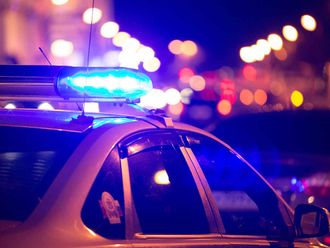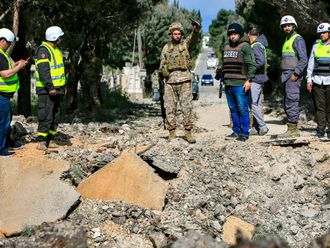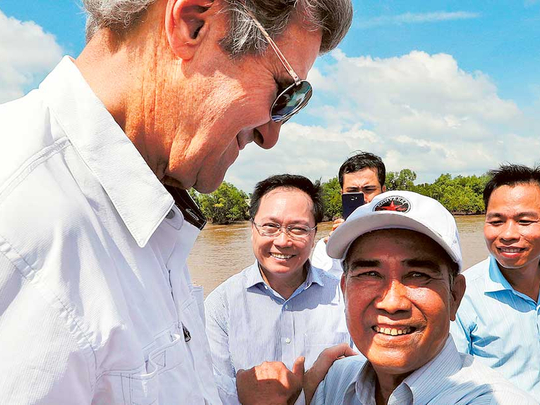
CA MAU, Vietnam: Viet Cong veteran Vo Ban Tam remembers the first time he crossed paths with John Kerry on the banks on the Bay Hap river, a day that ended in bloodshed.
Almost a half-century later, the now 70-year-old Mekong Delta shrimp farmer locked eyes with the US Secretary of State on Saturday and they warmly grasped hands in mutual respect.
Kerry returned to the Vietnam waterway at the end of a visit to the Communist nation, less than a week before he was to leave office, searching for the spot where he won a Silver Star for bravery as a young US Navy lieutenant.
On February 28, 1969, as the skipper of Swift Boat PCF-94, Kerry was patrolling when Vo Ban Tam’s unit launched an ambush.
The plan, the Vietnamese guerrilla told his former adversary on Saturday, was to use rifle and grenade fire to lure the heavily-armed American craft into range of a shoulder-held rocket launcher.
This tactic had paid off for the Viet Cong in the past but on this day Kerry made a dramatic decision, deliberately beaching his boat then storming ashore to pursue the operator.
Grabbing an M-16 rifle the then 26-year-old chased down the guerrilla and shot him dead, saving his crew from a counterattack.
Vo Ban Tam remembered the dead man, 24-year-old Ba Thanh, as a respected member of the Viet Cong’s main force in Ca Mau province, trained to use the prized launcher.
“He was a good soldier,” he recalled, speaking through an interpreter on the banks of same river, shortly after Kerry re-visited the scene of the ambush for the first time.
Kerry had never before learnt the name of the man he shot. During his unsuccessful 2004 White House campaign, opponents tarnished his war record by claiming he killed a teenager.
But US officials preparing for Kerry’s visit tracked down Vo Ban Tam and his account confirmed Kerry’s memory that his slain adversary was an adult.
Vo Ban Tam admitted that thanks to Kerry’s action the Viet Cong had not been victorious that day. But he recalled proudly how his comrades often had the upper hand.
“We were guerrillas, we were never there where you were shooting,” he boasted, telling Kerry they could hear his boat coming that day a kilometre off.
“Well, I’m glad we’re both alive,” Kerry said.
To die for a mistake?
Kerry returned from Vietnam later in 1969. Despite holding Silver and Bronze stars for valour and three Purple Hearts for being wounded in action, he became a prominent anti-war activist.
The tall, young, erudite Yale graduate stood out among veterans and his devastating testimony before a Senate committee in 1971 sealed his celebrity.
He forecast that Washington’s search-and-destroy missions and brutal pacification measures would fail to overcome the Vietnamese determination to resist foreign occupation.
On behalf of his own American comrades in arms, he famously demanded: “How can you ask a man to be the last man to die for a mistake?”
Kerry went on to become a senator, a presidential candidate and finally secretary of state — and he never forgot Vietnam, becoming a leader in the post-war reconciliation.
Now, with just days to go before the start of Donald Trump’s presidency marks the end of his tenure at the State Department, Kerry plans more visits.
He wants to work on environmental problems with the Lower Mekong Initiative while he and fellow veterans are involved in plans to open a US-funded Fulbright University in Vietnam.
Pollution and climate change are now the biggest threat to the Mekong Delta with encroaching salivation a huge issue — father of 10 Vo Ban Tam saw his entire shrimp stock wiped out last year by pollution.
The United States is a huge market for Vietnamese shrimp, but measures to deepen trade ties are threatened by Trump’s opposition to measures like the Trans-Pacific Partnership.
Sleepless night
Vietnam was the first stop on Kerry’s last foreign trip as Washington’s top diplomat, and he wanted to return there after meetings with senior officials.
Two days before he had been having a sleepless night in Hanoi’s French colonial-era Hotel Metropole, an aide told AFP.
Could he find the site of the ambush? He started pouring over Google’s online map, zooming in on the lazy curves of the Mekong Delta’s waterways.
He also called his former turret gunner from his boat to compare memories of the fateful day and prepare the expedition.
On Saturday, sitting on the prow of a tourist boat with Dartmouth College historian and Vietnam War expert Ed Miller, Kerry spread a copy of a war-era map across his knees.
Using the chart, Miller’s studies and his own memories he guided the vessel up the muddy creek.
Families came out of their homes to watch the small flotilla pass where decades before they might have fled for cover.
“This right here, where we are right now, was a very heavily Viet Cong controlled area,” he told reporters, noting that insurgent activity in Ca Mau went back to French rule.
Leaders in Washington back then had not understood this, mistaking a fight against Vietnamese self-reliance and patriotism for a Cold War geopolitical struggle, he argued.
The lessons of US failure in Vietnam have stayed with him as he studied more recent crises.
“It impressed on me the notion that you really need to analyse and understand what lies underneath the slogans,” Kerry told reporters on the boat.
And in a dig at George W. Bush, the president who defeated Kerry in 2004, he cited an example from the US war in Iraq: “It helps to know the difference between Sunni and Shia.”
And how did he feel himself, back at the scene of his own day of battlefield success within a much greater American failure?
“It’s weird. It’s a little surreal,” he said.
— AFP


